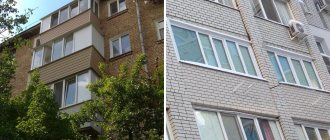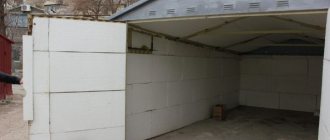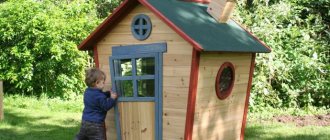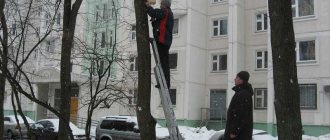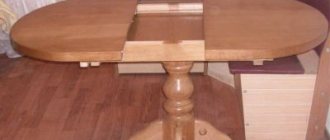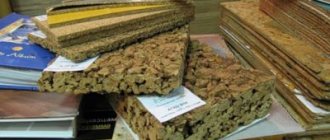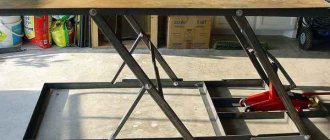What is the best way to insulate: outside or inside?
According to all construction canons, the best option is insulation from the outside. The thing is that the boundary between the thermal insulation material and the sheathing is the zone where condensation forms. And if you do insulation from the inside, then this zone falls between the insulation and the walls of the garage. At the same time, the latter freeze completely (through and through) in winter, which negatively affects the building material itself. Plus, condensation, which reduces the performance characteristics of any building material.
This is the first reason. The second is the ability not to reduce useful space in the garage. Insulation installed on walls takes up some space. Here you will have to add the thickness of the skin. That is, on each side of the walls there will be a reduction of approximately 3-5 cm.
The third reason makes it possible not to pay attention to the environmental friendliness of the thermal insulation material. It will be located on the outside, street side, which means that if the insulation releases substances harmful to humans, they will immediately evaporate. Moreover, such materials are much cheaper than environmentally friendly ones.
Insulation of the garage from the outside Source remstroiblog.ru
But it is not always possible to insulate the garage walls from the outside. If for some reason this cannot be done, then all thermal insulation work is moved inside.
Basic tips for insulating a garage
When insulating a garage, it is not recommended to skimp on the quality of the material. It is better to buy dense insulation: the higher this indicator, the better the material retains heat.
The most effective heat insulator is high-density polystyrene foam 35 kg/cub.m - PPT-35 and PPT-35N (N - for external use). When choosing insulation, it is important to correctly calculate the costs and take into account additional costs. To work with polystyrene, you only need fastening materials and a standard set of tools. The use of other thermal insulation materials - stone wool, polyurethane foam spraying, foam insulation - will require additional costs for the purchase of waterproofing and vapor barrier films, sprayers, and sometimes payment for the services of third-party organizations.
Overview of the thermal insulation materials market
Before moving on to the process of insulating a garage structure, let’s talk about insulation materials. About those that are used today for this purpose. There is a fairly large layer of building materials of this type that builders use today. There are traditional materials here, and others that have appeared recently, but have already gained popularity.
Mineral wool
This insulation has been used in construction for a long time. At the very beginning of its appearance, it was a roll-type material. Today it is still produced in this design, but the modern form of mineral wool is slabs. They are called mineral wool slabs.
It should be noted that a fairly wide range of materials is used as raw material in mineral wool slabs. But basalt-based insulation is very popular. This thermal insulation material is presented on the market in slabs of different densities and thicknesses. This makes it easier to select according to the required characteristics.
Mineral wool boards are a popular insulation material Source 2gis.kz
The only drawback of mineral wool is its hygroscopicity. That is, this material absorbs moisture well, while losing its thermal characteristics. To prevent this from happening, the heat-insulating layer is covered with waterproofing films on both sides. Today, manufacturers offer moisture-resistant mineral wool slabs, in which hygroscopicity is reduced to the maximum. This makes it possible to refuse waterproofing.
Will not talk about all the technical characteristics of mineral wool. Let us designate the most significant one, according to which you need to choose insulation. This is the thermal conductivity of the material.
On a note! Thermal conductivity is the property of a material or body to transfer heat. The lower this parameter, the better in terms of insulation.
So for mineral wool this characteristic is 0.035-0.04 W/m K.
Expanded polystyrene boards
Many people call this material foam plastic, which is fundamentally wrong, although both materials are included in the group of foamed plastics made from polystyrene. It’s just polystyrene foam – a material originally created for packaging. It has low density and low thermal insulation qualities. The same cannot be said about expanded polystyrene, which was originally developed as a thermal insulation material.
Moisture-resistant polystyrene foam boards Source www.stroyportal.ru
See also: Catalog of popular plots in the Moscow region for the construction of a country house
This foam insulation has serious advantages:
- thermal conductivity – 0.028-0.034 W/m K;
- the extruded version does not absorb moisture ;
- passes air through itself;
- strength – 1 kg/cm²;
- inert to many chemicals;
- mold and fungi do not live on the surface of the insulation
- it is a good sound insulator ;
- service life – 30 years.
But polystyrene foam boards also have their drawbacks. And the most important of them is fire hazard. The insulation burns well and maintains combustion, while emitting acrid smoke. Today, manufacturers are trying to change the situation with this indicator. Fire-resistant boards have already appeared on the market, but there are not many of them.
And one more point that you need to pay attention to when choosing expanded polystyrene as insulation. This is the brand of material. The optimal option for a garage is PSB-S-35 (40) - self-extinguishing, with a density of 40 kg/m³. The thickness of the slabs should not be less than 50 mm.
Expanded polystyrene boards brand PSB-S-35 Source karkasdomproekt.ru
Polyurethane foam
This is a two-component material, the ingredients of which are mixed before application. In terms of its physical state, it is a foamed semi-liquid mass that hardens in air, forming a hydrophobic layer on the insulated surface. That is, not afraid of moisture.
Application of polyurethane foam requires special equipment. It is applied under pressure from a hose with a nozzle. The high adhesive characteristics of the material give it the ability to adhere to any surfaces that are previously cleaned of dirt and rust. In this case, the mixture fills all the cracks, gaps and holes.
This is a non-flammable insulation. Service life – 50 years. Thermal conductivity – 0.019-0.028 W/m K. moisture absorption is minimal – 1.2%.
Layer of applied polyurethane foam Source foamshop.ru
See also: Catalog of companies that specialize in the construction of small architectural forms
Warm plaster
This plaster solution got its name because manufacturers add particles of heat-insulating material to its composition. These can be polystyrene foam granules, so-called crumbs, vermiculite (foamed rock of volcanic origin), sawdust and other ingredients.
In fact, such a plaster mixture has higher thermal insulation characteristics than conventional plaster. But to achieve a good effect, the material must be applied in a sufficiently thick layer. It is used both for insulating the garage from the inside and for thermal insulation from the outside. It is understandable if the garage is built from bricks, blocks or concrete slabs. For a metal structure this option is unacceptable.
Warm plaster is applied to the wall in a thick layer Source tk101.ru
So, we have looked at the main thermal insulation materials that are most often used today when insulating a garage building. Of course, this is not the entire list of proposed options. They just use these more often.
Most often, many consumers are looking for how to insulate a garage from the inside inexpensively. The table provides a comparison of prices for the described insulation materials.
| Insulation | Mineral wool boards | Expanded polystyrene boards | Polyurethane foam | Warm plaster |
| Price | 13-20 rub. for 1 m² | 15-50 rub. for 1 m² | 1200-1500 rub. for 1 m² | 350-750 rub. for 1 m² |
The price range for each material is quite wide. This is explained by the fact that the basis for pricing is the thickness of the insulation and its density. The table shows that the most inexpensive option is mineral wool and polystyrene foam boards.
The most economical thermal insulation materials Source krysha-expert.ru
Insulation materials
The interior of the garage consists of the floor, walls, ceiling and gate. Each is insulated separately:
- We insulate the walls with polystyrene foam, mineral wool, plaster, penoizol (liquid foam), polyurethane foam;
- Expanded clay is used for the floor, less often polystyrene foam;
- foam plastic, penoizol or mineral wool are used for the ceiling;
- the gates are lined with foam plastic.
An important indicator for all materials in this group is thermal conductivity. Below is a summary table of averages:
| Material name | Thermal conductivity |
| Foam plastic, penoizol | 0,036 |
| Expanded clay | 0,165 |
| Mineral wool | 0,038 |
| Foam concrete blocks | 0,28 |
| Cinder blocks | 0,64 |
The insulation of a garage from the inside is not made from blocks. New boxes for cars are built from them.
Lightweight porous insulation for the floor or foundation of a garage; it is a cheap material. The thermal conductivity of expanded clay is approximately 1.5 times higher than that of foam plastic, but 10 times lower than that of brickwork. This puts it in the middle position in terms of thermal protection. Not used for insulating garage walls.
Burnt expanded clay has a water absorption coefficient of no more than 20%, it is not afraid of sudden temperature changes, and does not burn. Expanded clay is harmless to the body, as it does not emit harmful fumes.
Mineral wool
This is a class of artificial insulation with a fibrous structure. It consists of rocks, glass and slag. Insulating garage walls from the inside with mineral wool is very common due to its high thermal insulation characteristics. According to this indicator, mineral wool is on the same level as foam plastic. It absorbs sound waves well and practically does not burn. Basalt mineral wool has high compressive strength.
The only negative is the high water absorption coefficient. It is possible to insulate walls with its help only with the condition of subsequent plastering or other hermetic sealing of the surface.
Styrofoam
The most effective, cheapest and most popular garage insulation. It consists of small granules, securely and hermetically sealed together. Do-it-yourself insulation of a garage with polystyrene foam from the inside is the most energy-efficient method.
Foam plastic has a low thermal conductivity coefficient. It does not absorb water and does not allow steam to pass through. This is a lightweight material that does not weaken the load-bearing capacity of the wall, ceiling or gate.
Polystyrene foam reacts chemically with many chemicals. It cannot be used in aggressive environments. During combustion, foam releases dangerous phenolic compounds.
Expanded polystyrene
The installation method is practically no different from foam plastic. It has a lower water absorption coefficient and higher density. Insulating a garage from the inside with polystyrene foam is more expensive than a similar operation using polystyrene foam.
Penoizol
This is an analogue of polystyrene foam for walls, which is applied in liquid form. Penoizol does not differ from polystyrene foam in its thermal conductivity characteristics. It has a combustion class of G-1. It absorbs water well, but does not accumulate in itself, but evaporates into the atmosphere. Penoizol is a hygroscopic, vapor-permeable insulation.
Insulation technologies
Having dealt with the question of how to insulate a garage, we move directly to the process itself. Let's start with external insulation. The simplest option is plastering. Everything is quite simple here. Warm plaster is applied to the external surfaces of the garage walls using standard technology. That is, they throw it onto the surface with a trowel and level it with the rule according to the installed beacons.
There is an option for mechanized plaster. To do this, special stations are used in which the plaster mixture is prepared and then immediately applied to the walls under pressure. In this way, insulation can also be carried out from the inside of the room.
Insulation of garage ceiling
The process is no different from insulating the walls inside the garage. It is necessary to remove all defects and chips and seal the seams. Everything follows the same principle as described in wall insulation.
Polystyrene foam adheres equally well to both reinforced concrete floors and metal sheets. But if you plan to cover the ceiling with some material, then you first need to make a wooden sheathing on the ceiling, lay foam plastic between the guides, and only then do the cladding.
Video description
In order not to go into details of the technological process, we suggest watching a video that explains how to properly apply warm plaster to walls in two ways:
Expanded polystyrene boards for external insulation
If the garage is built from bricks or blocks, then polystyrene foam boards can simply be attached to the wall surfaces, laying them tightly together. There are two mounting methods:
- on mushroom-shaped screws or, more precisely, on dowel-nails for insulating materials;
- on the adhesive composition.
Usually the first one is used, because glue for polystyrene foam is an expensive thing. It is sold in cans. The contents are applied to the back of the slab in the corners and in the middle. And then they just press him to the wall.
As for self-tapping screws, these are special plastic fasteners consisting of two parts: a dowel and a nail. Under the first one, a hole is made through the insulation in the wall into which the dowel is inserted. At the same time, its wide cap will hold the insulating board. After which the second part is hammered into it, which bursts open the first.
Dowel nail for insulation boards Source de.decorexpro.com
Typically, two fasteners are used for each slab. When laying thermal insulation, it is very important to ensure that there are no gaps or cracks between its elements. It is optimal to use slabs with a tongue-and-groove connection for this purpose. If ordinary slabs with smooth edges are used, then when gaps form between them, the latter are filled with special foam. It is similar to the assembly one, only it does not expand in volume when exposed to air.
How polystyrene foam boards are attached to the wall with mushroom-shaped nails Source stroyfora.ru
Insulation of an unheated metal garage
Periodic freezing and thawing of the car leads to rapid wear of the car's iron parts. To prevent this, keeping it warm and dry is essential. In winter, the most acceptable conditions for keeping the machine is a temperature of plus 5 or higher.
However, in a metal garage it is almost impossible to achieve this without using a heater.
That is why such a house for a garage must be insulated . If insulation is not carried out, then in winter the temperature inside the garage will be about minus 20.
When leaving the garage, you will have to warm up the engine for at least 5 minutes.
The presence of insulation will also help protect the interior from excessive overheating in the summer heat.
it is impossible to stay in it until it is ventilated .
So, to insulate the garage in such a way that in winter the temperature does not fall below 4-5 degrees, and in summer it does not rise above 25-28.
Important points
How to insulate an iron garage from the inside?
- The material covers all surfaces of the garage, including the floor.
- When laying roll or sheet materials, special attention should be paid to joints . To prevent cold from penetrating into the cracks, you need to overlap the sheets and connect them with aluminum tape.
- Pay special attention to laying material in the corners and joints of the garage structure.
- Particular attention should be paid to the gates. It would be ideal to build a small door in them so as not to open the gate completely every time.
- The insulating material must be mounted close to the metal parts of the garage, otherwise condensation . The resulting moisture will accelerate the corrosion processes, and the structure will become unusable in a very short time. That is why corrugated iron garages are recommended to be covered with liquid insulation materials that tightly cover the metal.
Tools and materials
To insulate an iron garage with your own hands, you need the following tool:
- electric drill;
- building level;
- metal scissors;
- hacksaw;
- screwdriver;
- roulette;
- wood stapler.
To install insulation you will need the following materials:
- wooden slats or metal profile;
- staples;
- self-tapping screws;
- brushes or rollers for applying insulating paint.
IMPORTANT! Don't forget to take precautions and prepare a mask and gloves for work.
Insulation of the floor and ceiling in the garage
The floor is easiest. This is a thick concrete screed, under which you just need to lay insulation. Expanded clay is most often used for this. They do it like this:
- At the site where the garage is installed, a pit is dug up to 50 cm deep.
- Crushed stone is poured into it in a layer of 15 cm.
- Then sand in a layer of 15 cm with compaction.
- Cover with roofing felt in two perpendicular layers.
- Expanded clay is poured.
- Another waterproofing layer .
- A reinforcing grid of steel reinforcement is laid.
- Pouring concrete.
You don’t have to fill in expanded clay, but use expanded clay concrete mortar instead of concrete. Instead of expanded clay, you can fill in perlite or lay polystyrene foam boards.
Layers of insulated garage floor Source mirstrojka.ru
As for the insulation of the ceiling, everything will depend on what this building element of the garage structure is.
- If it is a concrete floor slab , then it is better to assemble a suspended structure into which insulation is placed. You can use warm plaster.
- If it is a metal roof , then it is optimal to treat it with polyurethane foam.
- Since the roof of a metal garage is assembled, like the walls, in the form of a frame sheathed on the outside with iron, slab insulation . The technology is the same as on the walls.
What is insulated in the garage?
Comprehensive insulation of a building involves covering the walls, floor, ceiling and gates with thermal insulation. Depending on the type of garage and your own requirements, partial covering is allowed.
Walls
The bulk of the heat in the building is lost due to thin walls. There are several ways to sheathe the inside of the walls. The most accessible one requires the following steps:
- The walls are cleaned of old layers of plaster and paint. The uneven surface is treated with a cement-sand composition.
- After drying, the walls are covered with primer or an antiseptic to prevent the development of dampness and mold.
- Sheets of foam plastic or other material are glued to the prepared surface.
- A plaster mesh is applied over the heat-insulating layer.
- The wall is covered with plaster and putty.
A more expensive method involves the construction of additional partitions along each wall. The space between the walls and partitions is covered with an insulating layer, which minimizes heat loss.
Floor
Thermal insulation of the floor in a garage building is carried out using expanded clay or polystyrene foam. The coating function is performed by a cement-sand screed. To lay the thermal insulation layer, the following steps are carried out:
- A hole about 30 cm deep is dug along the perimeter of the room. The base is leveled and several beacons are placed, after which the installation horizon is determined using a building level.
- The bottom is covered with roofing felt or polyethylene. On each side the material is bent by 30 cm.
- Expanded clay is poured or foam is laid to full depth. The surface is leveled along the beacons, after which they are removed.
- A frame made of reinforcement and a beacon profile are placed on top of the heat-insulating material.
- The cement-sand screed is poured from the far corner. After pouring, the coating is leveled.
Gates
Even when closed tightly, a significant portion of the heat escapes through the gate. If you completely sheathe the perimeter, but leave the gate, the temperature in the room will remain almost unchanged.
To insulate the sashes, their inner part is covered with polyethylene, after which a frame made of wooden beams treated with an antiseptic solution is screwed to the canvas.
A heat-insulating material of appropriate thickness is placed inside the frame and glued to the inside of the gate using glue. The joining seams are covered with polyurethane foam. The thermal insulation layer is sheathed on top with clapboard or metal sheet.
Ceiling
According to the installation principle, insulating the ceiling is no different from treating the walls of the room. The material is fixed inside a frame made of metal or wooden beams. For additional protection, the frame is covered with sheets of plasterboard, clapboard or other finishing material.
Basic requirements for garage insulation
When insulating a car storage area, it is worth remembering a number of key points.
- Ventilation holes must not be sealed - any thermally insulated structure needs ventilation just as much as a heated one.
- Thermal protection should affect not only walls, but also garage doors, floors, and roofs.
- If you want to do everything according to the rules, it would be useful to study the sixth section of SNiP 2.07.01–89. It regulates the requirements for premises where vehicles are stored. Of course, when it comes to a personal garage, it is not necessary to comply with them. However, standards can help address a number of issues.
- To insulate the gate, in most cases, internal thermal protection is installed.
How to insulate garage doors
Not everyone knows how to properly insulate a garage from the inside. Effective and reliable thermal insulation of walls will not be enough, because a significant amount of heat escapes through the gate. The lack of insulation in this design will not allow the garage to warm up to the required temperature levels. At the initial stage of work, a hole is made in one of the doors and the doors are inserted. To reduce heat loss, a curtain made of thick fabric is fixed in this place.
A transparent polyethylene film with a minimum thickness of 0.8 millimeters will help to insulate the entire plane of the gate. This material is cut into strips 20-30 centimeters wide and fixed above the opening, so that the lower edge does not reach the floor surface by 1-2 centimeters. The strips are secured to a wooden beam using staplers. This insulation is very effective - when entering the garage, the driver will see the surrounding space. In addition, narrow strips of polyethylene will smoothly flow around the car and return to their original position.
Some car enthusiasts insulate the inside of their garage doors with polystyrene foam. To do this, a sheathing of wooden blocks is installed on the inside of the structure and the voids are filled with polystyrene foam slabs. To prevent cold air from penetrating through the gaps, the joints of the thermal insulation are taped with tape.
To eliminate drafts entering through the gates, it is necessary to replace the rubber seals. Condensation forms where the thermal insulation comes into contact with the metal surface. To prevent destruction, the steel is treated with paint or other anti-corrosion compound. Waterproofing substances are also applied to other surfaces.
The wooden guide elements of the frame are coated with a primer or heated drying oil, which will protect the material from rotting and exposure to fungus. After laying the foam, the surface is cleaned. Garage doors are finished with OSB boards or thin boards. It is not advisable to use moisture-resistant products for this, for example, gypsum board.
Insulation of brick garage walls
It is better to insulate garage walls from the outside, this way you can achieve more reliable and high-quality thermal insulation. If this is not possible, garages in cooperatives are located very close to each other, then you will have to insulate the garage from the inside.
Insulation can be attached in two ways - over a lathing made of a metal profile or timber, or directly to the walls using an adhesive solution.
Insulation of walls using lathing
Insulating a garage using an exposed frame (sheathing) allows you to organize high-quality ventilation of the space under the finishing and install reliable waterproofing. For the lathing, it is better to use soft insulation materials (mineral and glass wool in slabs or rolls) for thermal insulation.
We insulate a brick garage from the inside using frame technology:
- clean the walls from dirt and dust;
- we treat the surface with an antiseptic primer against mold and mildew;
- We install a frame made of timber or metal profile. The width between the vertical posts of the frame should be 2 cm less than the width of the insulation material.
Advice. In the garage, it is better to make a frame from lightweight metal profiles for installing drywall. They do not rot, are easy to install and are cheaper than wooden beams.
- the sheathing of a garage, up to 2.6 meters high, can be made only of vertical posts, without horizontal guides. But if dense mineral wool is chosen for insulation, then the horizontal guide is installed in increments of one meter;
- We lay film waterproofing along the frame with an overlap (5 – 10 cm). If the sheathing is wooden, then we fasten it with a stapler; if it is metal, then we can attach it with waterproof glue or tape;
- Now we are laying the insulation. It is important that there are no voids so that cold bridges do not form;
- we install a vapor barrier film, the connection is also overlapped by 5 - 10 cm. We secure the joints with tape;
- Afterwards, you can finish it with chipboard, plywood or gypsum plasterboard sheets.
In garages that are heated by air heaters or boilers, it is better to insulate the walls along the sheathing with mineral wool. Not foam.
External wall insulation is carried out in a similar way, but it is cheaper to insulate the walls from the outside with rigid insulation.
Rigid wall insulation
Insulating garage walls from the inside with polystyrene foam or expanded polystyrene using “hard” technology will cost less, but involves a lot of “wet” work.
We insulate the garage ourselves with polystyrene foam, the procedure for carrying out the work is:
- We clean the walls, remove all old damaged coatings (paint, plaster), smooth out uneven surfaces and chips.
Important. For good adhesion when installing insulation, the wall surface must be reliable and durable. Therefore, it is necessary to thoroughly clean the old walls with a wire brush.
- Apply a deep penetration primer. It is better to choose a primer that matches the brand of the adhesive mixture;
- we install the lower guide from the bottom of the wall, an aluminum profile or a wooden beam will do (be sure to treat it with anti-mold impregnation);
- Apply the adhesive solution onto the foam plastic, pointwise or along the perimeter and in the center with a spatula;
- starting from the bottom row, we mount the foam to the walls, it is important to press the sheet tightly and hold it so that the glue sets;
- rows of foam sheets are mounted with an offset of 15 - 20 centimeters;
- after installing all the foam sheets, you can additionally fix the insulation with dowels with a wide head (five dowels per sheet);
- We seal the joints with polyurethane foam. There should be no voids or gaps in the insulation layer;
- We install a mesh over the insulation and plaster the walls over it.
For a garage, the best adhesive mixture is “Ceresit” SM-11, frost-resistant, water-repellent. Plaster, plastic lining or siding are used as finishing walls.
Is insulation necessary?
To achieve a positive effect and ensure the desired microclimate inside the garage, it is necessary to pay attention to the insulation of all surfaces
This question is rather rhetorical. After all, any person wants his car to serve him for as long as possible - therefore, thermal insulation of the garage is a mandatory procedure.
Typically, a garage's structure allows the cold to pass through easily. Even when using cinder blocks or bricks, the thickness of the walls is not sufficient to provide comfortable conditions for storing a car, and constantly using heaters is too expensive and ineffective. For this reason, insulating the garage is the only sure way to solve the problem.
Typically, the thickness of a garage wall has the following indicators:
- for brick garages: ~25 centimeters;
- for cinder block walls: ~20 centimeters;
- for metal walls: depending on the thickness of the iron sheets, but almost never exceeds 1 centimeter.
To achieve a positive effect and ensure the desired microclimate inside the garage, it is necessary to pay attention to the insulation of all surfaces except the floor. Moreover, we should not forget about the gates - after all, it is not only the walls and ceiling that conduct the cold.
Additional insulation measures
Garage owners rarely insulate the floor, especially if it has an inspection hole. Of course, when the garage is part of the house and there is a basement underneath it, then there is no need for such work. But if the floor freezes, then this problem also needs to be solved.
The inspection hole is always equipped in such a way that it is located below the ground freezing point. Therefore, condensation forms on its walls, which leads to an increase in humidity in the room. This problem is quite easy to solve. You can install an insulated cover on the pit.
The floor in the garage can be deepened a little (by 30-35 cm), covered with a small layer of crushed stone (about 7-10 cm), then with a layer of sand of 5-6 cm and all this compacted tightly with a roller. Then a layer of well-heated bitumen should be applied, and a concrete screed based on a metal mesh should be placed on it.
Whether it is necessary to insulate a garage, everyone decides for themselves.
Although the technology for carrying out the work is not at all complicated and is quite accessible for independent implementation. It is enough to be attentive and careful.
